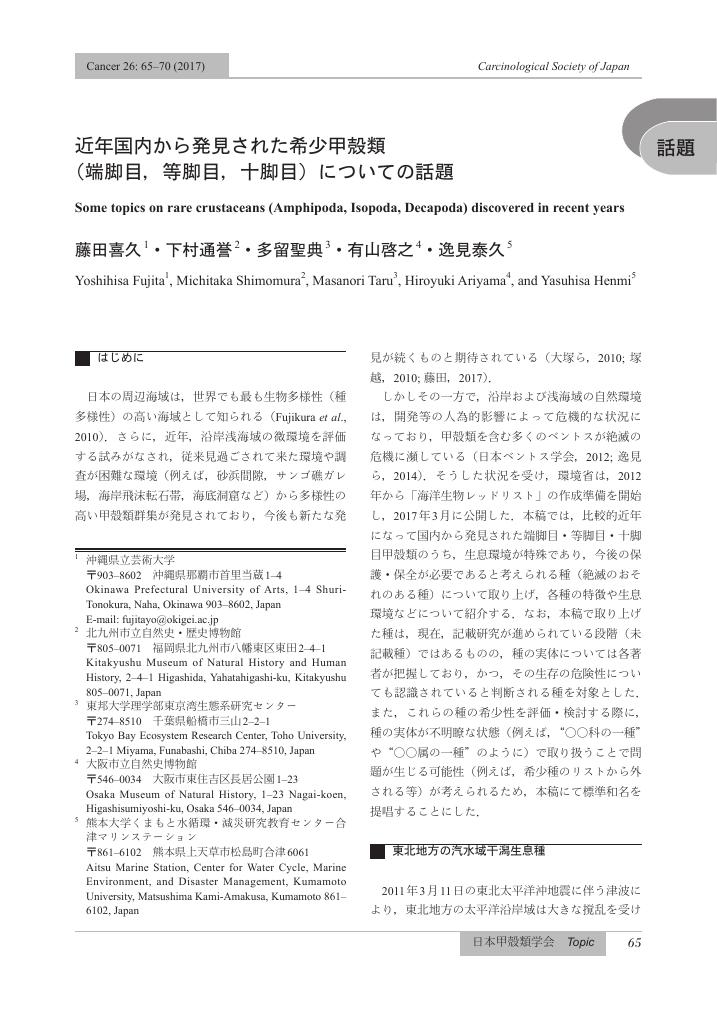6 0 0 0 OA 近年国内から発見された希少甲殻類(端脚目,等脚目,十脚目)についての話題
- 著者
- 岩崎 敬二 木村 妙子 木下 今日子 山口 寿之 西川 輝昭 西 栄二郎 山西 良平 林 育夫 大越 健嗣 小菅 丈治 鈴木 孝男 逸見 泰久 風呂田 利夫 向井 宏
- 出版者
- JAPANESE ASSOCIATION OF BENTHOLOGY
- 雑誌
- 日本ベントス学会誌 = Japanese journal of benthology (ISSN:1345112X)
- 巻号頁・発行日
- vol.59, pp.22-44, 2004-07-28
- 被引用文献数
- 24 26
To investigate the invasion history and recent geographic distribution of marine organisms introduced to Japan or transferred domestically to non-native regions, a questionnaire survey on their occurrence in the field, including both published and unpublished records, was conducted in 2002-2003. A total of 105 taxa was reported by 94 respondents. According to three criteria, viz. known or unknown geographic origin, established invasion history, and presumed dispersal mechanisms associated with human activities, 42 taxa were designated as non-indigenous species introduced to Japan through human activities, 26 taxa as indigenous species that are distributed both in Japan and other countries but are introduced from abroad to Japan for fisheries or as fish bait, 20 taxa as cryptogenic species which are not demonstrably native or introduced, two taxa as non-indigenous species that have extended their range to Japan through natural dispersion, and one taxon as an indigenous species. The remaining 14 taxa were considered to have been transferred domestically to new areas. Analysis of the years of first record of 42 non-indigenous species suggests that the rate of invasion has increased over the past century, with seven or eight species being introduced per decade after 1960. Data on temporal change in geographic distribution revealed that many non-indigenous species have become widespread recently, from the Pacific coasts of central Japan to the coasts of the Sea of Japan or northward. However, the species listed in the present study are not exhaustive, and more extensive investigations covering all taxa and all presumed dispersal mechanisms are urgently needed before consideration of legislative management of introduced marine organisms.
1 0 0 0 屋久島における森林棲鳥類の垂直分布 : II.非繁殖期
- 著者
- 江口 和洋 武石 全慈 永田 尚志 逸見 泰久
- 出版者
- 一般社団法人 日本生態学会
- 雑誌
- 生態誌 (ISSN:00215007)
- 巻号頁・発行日
- vol.42, no.2, pp.107-113, 1992
- 参考文献数
- 17
- 被引用文献数
- 1
A research on the altitudinal distribution of forest birds was conducted on the Yakushima Island, south-western Japan, in winter, 1983. Three types of the assemblages of dominant bird species were recognized in respective plant formations from the coastal area to the mountain top : Hypsipetes amaurotis, Zosterops japonica and Parus varius in an evergreen broad-leaved forest (40-900 m) and in a Cryptomeria forest with evergreen broad-leaved trees (900-1200 m), Z. japonica, P. ater, Troglodytes troglodytes and P. varius in a Cryptomeria forest with deciduous trees (1200-1555 m), and Z. japonica, Turdus naumani and Emberiza cioides in a mosaic of a scrub of Pseudosasa and Cryptomeria forest (1555 m-1886 m). Overall, of the thirty-two species recorded, twenty-two were residents and ten were winter visitors. Of the seven dominant residents, three species shifted downward, one shifted upward, and three did not shift from their breeding sites. Winter visitors were characterized by many seed or fruit eaters, or ground-foraging insectivores and no canopy-foraging insectivores, which is in contrast to summer visitors. Winter visitors mainly invaded the Cryptomeria forest with deciduous trees or shrub in a forest edge, the habitats being liable to a great seasonal change.
1 0 0 0 OA 寄生性等脚類ウミホタルガクレOnisocryptus ovalisの繁殖戦略
- 著者
- 岡本 直子 逸見 泰久
- 出版者
- 日本ベントス学会
- 雑誌
- 日本ベントス学会誌 (ISSN:1345112X)
- 巻号頁・発行日
- vol.57, pp.75-78, 2002-06-27 (Released:2009-08-07)
- 参考文献数
- 8
- 被引用文献数
- 1 1
The reproductive strategy of the parasitic isopod Onisocryptus ovalis in the luminescent ostracod Vargula hilgendorfii was studied at a beach in Kumamoto Prefecture, Japan, and in the laboratory, mainly from April 2000 to May 2001. Onisocryptus ovalis is a protandrous hermaphroditic species and changes from a mobile male to an immobile female that loses most of its appendages and has a sack-like body. Male parasites O. ovalis invade female hosts V. hilgendorfii, eat the host eggs, change sex, produce eggs, and die after the eggs have hatched. Some parasites invade immature or male hosts, but move to female hosts immediately afterwards. The percentage of hosts parasitized by O. ovalis was low (0-18%) from summer to autumn, but increased greatly (28-91%) from winter to spring mainly because of a shortage of hosts. Usually, one or two male parasites were found in a host, and only one male of them changed sex. From winter to spring, however, up to 8 male parasites were found in a host and a maximum of five changed sex. The most adaptive parasitic strategy of O. ovalis seems to fertilize eggs as a male as many times as possible, and then to produce more eggs as the only female in a host, although these parameters are not available at present.
